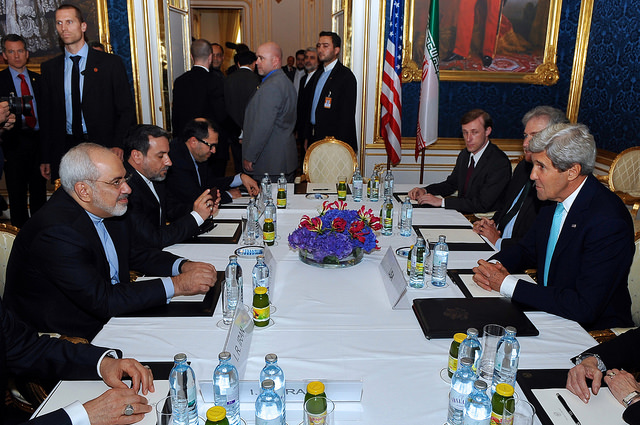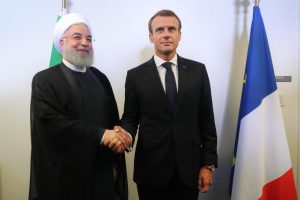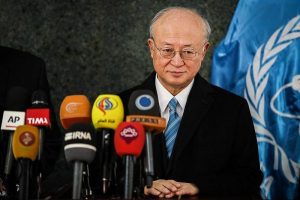by Peter Jenkins
So much has been written and said about the uranium enrichment aspect of the 14-month nuclear negotiation with Iran that it is hard to look at it with fresh eyes, and starting from first principles. Nonetheless what follows is an attempt to do so. It suggests that the US and Iran are closer on enrichment than once seemed possible, but are still at risk of failing to find common ground in the course of the extension agreed a week ago.
From an international legal perspective the text that matters is the Nuclear Non-Proliferation Treaty (NPT), to which Iran deposited its last instrument of ratification on 5 March 1970, the same day as the deposit of the US instruments. Under the NPT the US is a “Nuclear Weapon State,” Iran a “Non-Nuclear Weapon State” (NNWS).
The NPT does not prohibit the acquisition of enrichment technology by NNWS. Nor does it impose any limit on the size or number of NNWS enrichment facilities. It merely requires NNWS to use that technology exclusively for peaceful purposes, and to place all the nuclear material fed into and produced by such facilities under International Atomic Energy Agency (IAEA) safeguards.
In the current negotiation, Iran has assured the US that it takes its NPT obligations very seriously. It has also reaffirmed its intention to use enrichment technology exclusively for peaceful purposes, and to continue to implement the NPT safeguards agreement that it concluded in 1975.
Some people assume that such assurances are worthless. They point to the breaches of the NPT safeguards agreement that occurred between approximately1991 and 2003. However, none of those breaches amounted to evidence of an intention to use enrichment for non-peaceful purposes. And US intelligence has yet to come across any such evidence; suspicion of Iranian nuclear weapon intent has rested on inference, not evidence. States, like people, can make mistakes and then resolve not to repeat them.
There are also several resolutions adopted by the UN Security Council (UNSC) between 2006 and 2010 that make legal demands of Iran. But none of them imposes limits on the size and number of Iranian enrichment facilities. Still less do any of them outlaw Iranian possession of enrichment technology for peaceful purposes. One of them requires Iran to cooperate with the IAEA to resolve concern that Iran has engaged in research into nuclear weapon-related technologies. Iran has been doing that since November 2013, albeit with increasing hesitancy.
In the Iranian case another perspective is as important as the legal perspective; it is the confidence-building perspective. This was crucial to an attempt to resolve the problem peacefully in the wake of the IAEA Director General reporting the safeguards breaches to which reference is made above, because these breaches had undermined confidence in Iran’s peaceful intentions.
In the autumn of 2003, Iran volunteered, in the interest of confidence-building, to go beyond the requirements of its NPT safeguards agreement and make available to the IAEA the information and access required by the Additional Protocol (AP). Tehran also undertook to suspend activity at its only enrichment facility while it negotiated longer-term confidence-building measures with the UK, France and Germany (E3). The Iranians implemented these short-term measures scrupulously and ceased doing so only after they had grasped that nothing less than renunciation of the enrichment option would satisfy the E3.
In the current negotiation, various reports suggest that Iran has so far volunteered to renew application of the AP, de facto initially and later de jure; to accept limits on the size and number of its enrichment facilities during a confidence-building period; to refrain from producing uranium enriched to more than 5% U235; to convert some of its under 5% U235 uranium (LEU) into forms in which it would not be readily available as feed material; and to send the rest of its LEU stock to Russia for use in the fuel that the Rosatom corporation is supplying to the power reactor at Bushehr. Iran’s negotiators also have reportedly suggested that they are ready to extend the Bushehr fuel supply contract well beyond 2021.
In parallel, Iran has negotiated that Rosatom will help build two further power reactors and will supply them with fuel throughout their operating lives.
In confidence-building terms, this amounts to an impressive package. With only 10,000 IR-1 centrifuges in operation in only one facility, and its LEU stock unavailable to serve as feed material, Iran would need at least six months to produce enough highly enriched uranium (HEU) for one nuclear device. With only 8000 IR-1s and no LEU feed, Iran would need at least eight months.
And if the Bushehr supply contract were extended to 2031, Iran would only need to consider increasing the available quantity of separative work units (a measure of centrifuge output) in the late 2020s.
In other words, Iran is offering a package that exceeds its NPT obligations by a wide margin. IAEA inspectors would be able to acquire confidence that there are no undeclared nuclear activities or material in Iran. The international community would know that it had six to eight months at least to react to any sign of Iranian misuse of its enrichment capacity for non-peaceful purposes.
So why in Vienna did it seem that this package is not enough for the US? That is for representatives of the US administration to explain. Past statements suggest that they will say that they need certainty that Iran will be incapable of producing (“cannot”) even one nuclear weapon.
That may sound reasonable but is in fact an unrealistic goal. It would require Iran not only to destroy all its centrifuges but also to wipe the minds of its engineers clean of all their knowledge and experience of enrichment technology. It also puts the negotiation at risk of the same fate as the 2003-5 E3 negotiation, because Iran is unready to build confidence by closing down its enrichment program. And it runs counter to the spirit of the NPT, since the NPT bases nuclear non-proliferation on self-restraint, political will, and deterrence through verification, not on nuclear technology surrender.
If instead the administration admits that it cannot literally “close all pathways” to a weapon but claims that it needs at least 12 months to react to any break-out attempt, then they should be asked why six to eight months would not be enough.
It is self-evident that 12 months of additional sanctions would not cause Iran to abandon a break-out attempt. Eight years of sanctions have failed to persuade Iran to re-suspend enrichment. Post-1918 history is littered with failed sanctions policies.
On the other hand, 12 months are more than are needed to get UN Security Council approval for the use of force to prevent break-out and to act on it—or for a coalition of the willing to form in the unlikely event of Russia or China threatening to veto a UNSC resolution. In 1990, only six months were needed for the US to gain approval for and prepare a massive operation to drive Saddam Hussein out of Kuwait. As recently as last April, Secretary John Kerry was formulating the goal as “six to 12 months.”
This analysis will be misconstrued by some as an apologia for Iran. Others will realize, I hope, that it is an attempt to clarify the progress that has been made on enrichment over the last 12 months; to explain why the current Iranian offer is reasonable from a legal and from a confidence-building perspective; and to counter the pernicious influence on US negotiating goals of people who want the bar set so high that Iran will refuse the jump.






Excellent. My additional comments (I know you didn’t have space to cover everything.)
“Iran would need at least six months to produce enough highly enriched uranium (HEU) for one nuclear device.”
–Iran’s enrichment activities are fully monitored by the IAEA which has reported quarterly that “The Agency continues to verify the non-diversion of declared nuclear material at the nuclear facilities and LOFs”
–A nuclear device can’t be fabricated from highly enriched uranium (HEU), the gas UF6 or uraniumhexafluoride, an extremely aggressive chemical. The gas must be converted to a metal, then fabricated into an implosion warhead, tested, etc — a lengthy process. Consider that when he word “breakout” is used with respect to this Iran issue. Clinton Bastin, nuclear scientist: “Iran would need 10 to 15 years to make a weapon, after diversion of low-enriched uranium, which would be immediately detected by IAEA inspectors.”
“So why in Vienna did it seem that this package is not enough for the US?”
–The nuclear issue has been concocted and resolution was never an option. The sanctions on Iran started after it became an Islamic Republic and before the nuclear issue was dreamed up.
–The US has sanctioned Iran on other pretenses also: human rights abuses (pot/kettle), deceptive banking, faulty elections (pot/kettle), evading sanctions etc. Another sanctions basis is that the US considers Iran to be “the world’s largest state sponsor of terrorism” although that charge is concocted also; there are no Iranians on any US terrorist list.
I would need some clarifications: Why UN allows some known nuclear countries not to ratify or even apply for ratification of NPT and at the same time to be members in good standing of IAEA (Atoms for peace) and not to be sanctioned by UNSC? What makes them more trusted that Iran who to my knowledge ratified NPT and is under constant IAEA safeguards checks and have been under heavy sanctions from UNSC and other power players in the world. From Iranian point of view it must be regarded to be discrimination. What are all confidence-building steps of power players worth if this basic disproportion is not addressed? Or is there something I do not see why this is allowed?
@CanuckBC
India, Pakistan and Israel are acceptable non-NPT nuke nations because they are US allies. Iran is an unacceptable NPT non-nuke nation because it is a designated US enemy, often coupled these days with DPRK (North Korea). The US has controlled the UNSC, but that may be changing.
The “right to enrich” is principally restricted by the West (especially US and France) for financial reasons whereby it provides the uranium fuel, and also just because it can. Since enrichment under the NPT is fully surveilled by IAEA it makes no other sense. Recently, the US has successfully prohibited its ally South Korea (ROK) from enriching, even though ROK builds nuclear reactors at home and abroad. They do what they’re told because the US has 28,000 troops there. The Iran situation is different.
Thanks Don! Yet one more question remains: how US government can pretend to be a honest broker dealing with issues on hand in good faith, with straight face. Not only that but they constantly are saying that Iran is not dealing in good faith. Are we people simply crazy not to see this? I hope American people will find a honest, untarnished leader as for example Ron Paul and sweep out all the garbage dealers from power.
To CanuckBC, the U.S. does it because it can, not because it’s fair. As for sweeping out the garbage, I’m not sure that they make that kind of man or woman that is able to follow through anymore, though I might be wrong?